Ashwagandha is a truly magical shrub, with gorgeous lanterns surrounding their fruit, and roots with tons of traditional health benefits that are sold in powdered and fresh forms all over the world in health food shops to cure ailments from insomnia and stress to sexual dysfunction.
While we’re not doctors, and we’re certainly not advising any health uses in this article, we can definitely run you through exactly how to grow these beautiful plants here in Australia to add a little bit of fairy tale magic to your garden.
More...
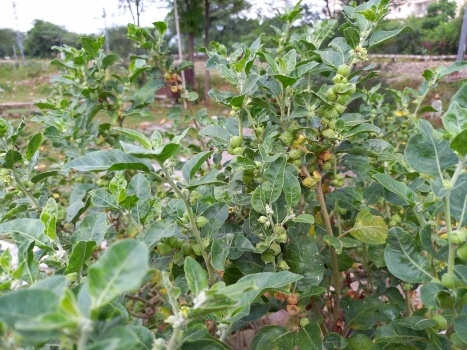
Source: Nature of Home
Family: | Solanaceae |
|---|---|
Genus: | Withania |
Species: | W. somnifera |
Common Names: | Ashwagandha, Winter Cherry |
Location: | Outdoors, protect from frosts |
Type: | Half-hardy shrub |
Growth: | 1x1m |
Sun requirements: | Full sun, bright light |
Foliage Colour: | Bluey green |
Flower Colour: | Green to white |
Flowering: | Mid to late summer |
Fruit: | Edible fruit in autumn |
Maintenance level: | Low |
Poisonous for pets: | Non-toxic to cats and dogs |
What is Ashwagandha?
Withania somnifera, or Ashwagandha, is a species of flowering shrub with nightshade-like foliage and thick underground roots, which are woody when dried.
Growing to about 1m tall at maturity, this close relative of nightshade is often mistaken for potato when it first germinates and has surprisingly similar flowers before developing physalis-like lanterns with red, papery casings that wrap around soft, bitter berries.
They are tropical plants, and should be protected from frost, but are hardy through most of Australia.
Thankfully that’s pretty easy to do, as they are best grown in pots to make sure they have truly excellent drainage, and controlled water to prevent any chance of root rot (because if you are planning to harvest them, keeping those roots as dry as possible is essential).
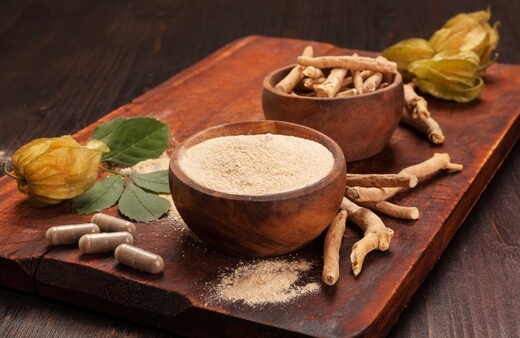
Natural Habitat of Withania somnifera
Native to India, and spread naturally throughout the Middle East and Northern Africa, Ashwagandha is part of the Solanaceae family. The Solanaceae family includes potatoes, tomatoes, peppers, and, perhaps the most similar, deadly nightshade, whose flowers, foliage, and roots are nearly identical to Withania somnifera.
The key difference, and the important identifier, is the seed pods, which look like tiny red lanterns. When they develop and dry out, the roots are ready to harvest, and the fruit can be eaten too (though it is a diuretic and incredibly bitter so perhaps not the most welcome addition to a salad).
Is Ashwagandha edible?
Like its distant cousins in the solanum family, ashwagandha has toxic stems and leaves, packed with a poisonous group of chemical compounds called solenoids. But, just like tomatoes and peppers, berries are edible, and like potatoes, the roots can be eaten raw, dried, or powdered.
The shrubby habit of ashwagandha and the fact it is perennial makes it much easier to manage than most of its relatives, as it will grow back each year from the same stems without the need for pruning.
The fruits grow from flowers on the ends of stems, not adapted trusses, and the roots can be harvested by up to 2/3 on mature plants, which will regrow from just 1/3 of their root ball each year.
Both the roots and fruits are bitter and fairly unpleasant to eat, but when covered with honey and other sweet flavours are said to have multiple health benefits.
What are the uses for ashwagandha?
The fruit of ashwagandha has limited health benefits and is typically used as a diuretic, so it’s the roots that are the truly valuable part of these plants. Ashwagandha roots are said to be sleep-inducing, and are sold alongside, and often in combination with valerian root to help cure stress, anxiety, and insomnia in mild cases.


Get Your Free Guide:
Master Growing Australian Natives eBook
A Must Have Complete Guide for Every Australian Garden
Get Your Free Guide:
Master Growing Australian Natives eBook
A Must Have Complete Guide for Every Australian Garden
As with any herbal remedy, it’s important to consult your doctor for advice about contradictions with current medication, and potential allergens before self-prescribing herbal remedies.
Growing Ashwagandha in Australia
Growing ashwagandha is really quite simple. Pop young plants into a pot with the right soil, in good sun, and let them thrive. Dig them up whenever you need to harvest their roots, and plant them back into the soil.
There’s very little need for pruning, other than to control their ultimate size, and watering is a rarity generally provided by the clouds!
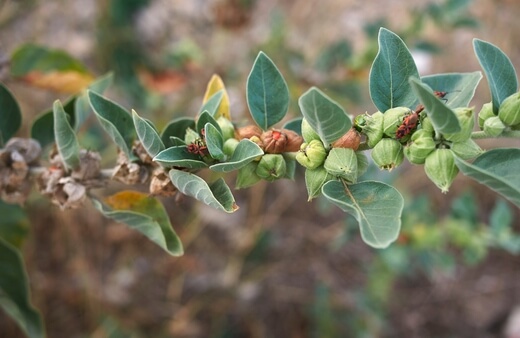
Best Conditions for Planting Ashwagandha
Soil for Ashwagandha
Australian garden soil is typically sandy and free-draining, as well as nutrient-rich, so choosing the right spot in the garden should be a doddle. If you’ve got raised beds packed with moisture-retentive materials like compost, manure, or soil improvers, grow ashwagandha in pots where they can thrive in free-draining conditions.
Gently acidic soil is ideal, so if you’ve got a pH tester, try to find a soil mix that is around 6.5 pH.
Light Preference
By far the most important thing for ashwagandhas is light. Any less than 6 hours of direct light and will fail to develop, and their roots will stunt. Find a bright spot, somewhere warm, and with access to rainfall to keep maintenance to a minimum.
Temperature
The second most important factor in choosing a good spot for ashwagandha is temperature. They need to be kept above 12°C even in winter, so in Tasmania or similarly cold regions, move them into greenhouses over winter where they can be kept alive for next spring.
Container Size and Spacing
Ashwagandha roots are the most vigorous parts of the plant and should be given enough space to thrive. Choose a pot that is deep enough and wide enough to allow for root expansion, and trim the roots each year to keep it in the same container.
The minimum pot size should be 1 ft wide by 1 ft deep, but bigger is generally better. Because of this, there will be opportunities for soil to saturate, so stick to the free-draining soil rules from above to ensure the soil doesn’t become boggy around young plants in containers.
Water and Drainage
Ashwagandha, despite its dislike of damp conditions, should be watered in well at first, so that water runs out of the base of its pot. After the first few weeks, stop watering altogether to avoid overwatering.
In cooler parts of the country, or if you grow ashwagandha in a greenhouse just keep an eye on the soil as it can often drain faster in heightened or artificial temperatures and may need extra water to stop the soil from becoming bone dry.
How to Propagate Ashwagandha
Ashwagandha, like any relative of the Solanaceae family, propagates most easily from seed, but it’s equally possible to make new plants from stem cuttings. Follow our guides to each method below:
Propagating Ashwagandha from Seeds
It’s really easy to find ashwagandha seeds online, and even easier to germinate them. Provided you can provide soil temperatures of 15°C or higher, they will happily germinate.
- Fill small plastic pots with seed compost, and sow two seeds per pot.
- Leave them on a sunny windowsill, heated propagator, or even a sunny porch in summer.
- Water them just enough to keep the soil moist until they germinate (two weeks usually)
- Thin the seedlings so only the strongest remains in each pot, and keep them gently moistened, and in warm, bright locations until they are big enough to plant out.
Ashwagandha Propagation from Cuttings
To take ashwagandha cuttings, you’ll need a few basic tools; rooting hormone, tall plastic pots, perlite, and sharp bypass secateurs.
- Start by selecting a healthy, non-flowering stem in spring (softwood or semi-hardwood cuttings both work).
- Cut the base of the cutting just below a node, and remove all the leaves so you are left with just the top-most foliage on a 10-15cm length of the cut stem.
- Insert the stem into a tall plastic pot filled with a 50:50 mix of compost and perlite.
- Water it well, and leave it somewhere bright, but out of the direct sun for about 1 month, watering whenever the soil dries out.
- When new leaves or buds appear, there should be signs of roots at the base of the pot.
- Keep them in their small pots for now, and move them onto new pots when there is about 5 cm of new growth.
Caring for Withania somnifera
In most of Australia, ashwagandha is semi-evergreen, holding onto their leaves, and even some of their lanterns, right through winter if left unharvested, and misty winter mornings, with low morning sun, shining through those lanterns is just magical.
In cooler parts of the country, you might see some leaf drop, and even a defoliated tree, but if you protect it from frost, it will usually come back the next year.
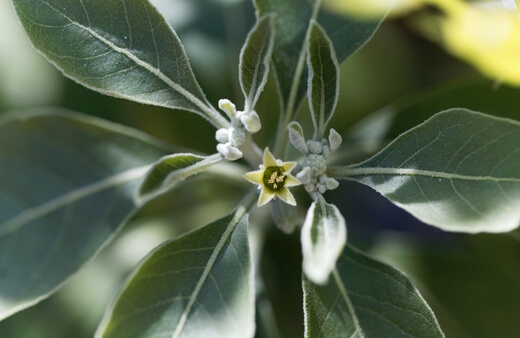
Mulching
Over winter, it can be beneficial to mulch around the base of ashwagandhas if they are left outdoors. This is just to mitigate the risk of frost in areas where frost is rare but possible and protect the roots from temperatures below 10C.
In warmer parts of the country, apply a mulch of organic compost or even grass clippings in spring to boost nutrient levels without affecting drainage too heavily. Try to leave a 2 cm gap between the mulch and the main stem to prevent crown rot or fungal problems at the base of your plants.
What Fertiliser to Use
I have always found that a basic tomato fertiliser works well for ashwagandha, but liquid seaweed would provide the same benefits. One monthly feed is enough to provide balanced nutrients either in addition to, or in lieu of, mulch.
Pruning Needs
Never cut back ashwagandha if it isn’t dead, damaged, or diseased. In some cases, where the branches are crossing and rubbing on each other, it’s sensible to remove one of the crossing branches to limit the chance of friction damage, which can create fungal problems. Aside from that, pruning isn’t necessary.
Over Wintering Ashwagandha
Ashwagandha will survive quite happily outdoors in Australia, but in extremely cold parts of the country or anywhere with a risk of frost it's sensible to overwinter them in greenhouses, cold frames, or provide them with a fleece cover ahead of cold nights.
Harvesting Ashwagandha
Despite its incredible beauty, most people grow ashwagandha purely as a healthy food. Personally, I think that’s to forget about the mental health benefits it can bring in itself, but that doesn’t mean you can’t have the best of both worlds.
So, if you do plan on harvesting the berries or roots of ashwagandha, follow the guide below to get to grips with when, how, and why to harvest them.
Preparing Ashwagandha Roots
The most important part of the ashwagandha in terms of herbal remedies is the root. The roots can be harvested at any time of year, but it's best to dig them up in winter when the plant is largely dormant.
While you can get away with taking 2/3 of the existing roots, it's best to leave 2/3 instead, and take just 1/34 of the roots, as your plant will recover better in spring. After harvesting the roots, dry them out in a low-humidity, high-temperature space (this can be the oven, or a windowsill provided it’s well-ventilated.
Once dry, they can be ground, or sliced and used in tea, warm milk, or simply chewed. Ashwagandha roots are a less effective alternative to valerian roots but are well worth trying as an easy-to-grow home remedy for sleep problems.
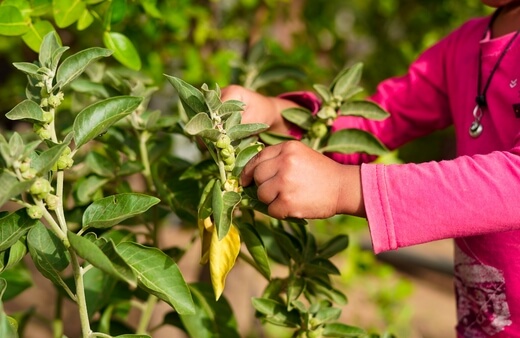
Harvesting Ashwagandha Berries
The berries of ashwagandha plants are concealed until harvest time in bright red or orange, lantern-like parcels. When the skin begins to dry out it turns to a papery-brown colour, and naturally opens up slightly at the base.
You can eat them raw with all the same health benefits, but they are incredibly bitter so it’s best to dry the berries to give a kick to other food or mix them into drinks with sweeteners like honey or even Grevillea nectar for a natural native alternative.
Ashwagandha berries are best used as a diuretic, and have very few other health benefits though, so unless you’re trying to flush your system, stick to the roots.
Withania somnifera Pests and Diseases
There are a few common ashwagandha pests and diseases, but none are specific to ashwagandha, and all are widespread throughout Australia, so if you notice problems they are not generally worth worrying about, other than if they get out of control.
To help guide you through organic prevention and cure for the most common ashwagandha pests and diseases, we’ve put together a brief and concise guide below.
Cutworms
Large caterpillars with spiked ends are generally grouped as cutworms, they are not a specific species and can be multiple colours, and are nearly all moth caterpillars. The most common cutworm on ashwagandha is the caterpillar of the Agrotis moths, which consume several leaves per day, per caterpillar.
The only reliable and organic way to get rid of cutworms is to pick them off by hand and feed them to wild birds. If you’ve got a bird feeding station in the garden, just drop them onto the table and they’ll make a wonderful snack for native species.
Leaf Miners
The smaller caterpillars that burrow into the surface of leaves, and eat away at the cells inside are called leaf miners. They create dead, yellow patches on foliage, and are fascinating if you find them.
They are hard to spot, but if you hold a damaged leaf up to the light, you can often see the caterpillar wriggling away inside. Discard the affected leaves, and remove fallen leaf litter from around the plant to prevent a recurrence.
If the problem persists, neem oil will create an uninhabitable space, either by using neem cake as a soil treatment, or neem spray directly on foliage.
Aphids & Mealybugs
Aphids and mealybugs are quite common in the fresh spring growth of ashwagandha. In large enough numbers they can stunt the growth of young plants, and prevent buds from opening if they become encased in the insect’s secretions (honeydew).
Spraying them off with a strong jet of water is the safest, organic way to get rid of them without harming other beneficial insects. All of the insects above can cause fungal problems, but there are, thankfully, no common bacterial problems in Australia that dramatically stunt the development of ashwagandha.
Root funguses, like Fusarium solani, are carried in the soil, and moved from plant to plant by burrowing insects and dirty tools. Other topical funguses like blights and crown rot are spread mostly by insects and thrive in overly damp or humid environments.
To prevent these fungal problems, simply maintain a well-drained container, and use clean tools. To cure them use organic fungicides like neem oil or copper fungicides for soil treatment.
If you are going with the former, be sure to read our comprehensive guide to neem oil to learn its types and how to use them the right way.Ashwagandha Frequently Asked Questions
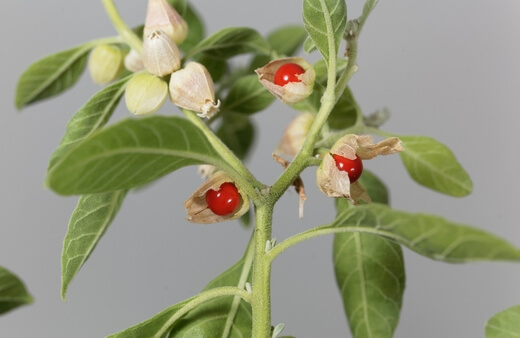
Is ashwagandha safe to use as a medicine?
Ashwagandha should only be used when you are certain you have no allergies and there are no contradictions with your current medication or conditions. Many sleep conditions, including sleep apnoea, are affected by herbal remedies, so check with your doctor before taking any herbal remedy.
How long does ashwagandha root take to work?
The clinical effects of ashwagandha are relatively unknown and much understudied, but most evidence shows that it becomes effective after two to three weeks of regular dosages, typically taken in the evening, for the treatment of mood or sleep disorders.
Is ashwagandha safe for people with heart conditions?
Ashwagandha is often advised as a solution to stabilise blood pressure, but there are contradictions with many users reporting irregular heartbeats developing after beginning to take ashwagandha.
If you have a pre-existing heart condition, consult a doctor before taking ashwagandha root in any form.
What does Ashwagandha do for your body?
Ashwagandha has no proven medical uses, but is generally considered to have a calming, anti-stress effect, and be useful as a remedy for sleep deprivation. It’s also used to lower blood pressure and reduce swelling in some cases and is widely considered safe to use as a supplement.
What happens if you take ashwagandha daily?
Taking ashwagandha daily could potentially help to reduce blood pressure, chronic inflammation, and stress. However, it does need to be taken daily for several weeks before changes are noticeable.
Is Ashwagandha easy to grow?
Ashwagandha is expensive to buy as a herbal remedy whether it is prepared as a powder or tablet, so growing your own at home is a great way to save some money. It’s easy to grow ashwagandha too, just as long as you have good sunlight, and reasonably well-drained soil.
How long does it take to grow Ashwagandha?
Ashwagandha grows from seed to harvest in about 6 months and works well alongside other garden veggies in raised beds. The roots are the main part worth keeping, so it's best to resow ashwagandha every year to keep a constant supply if you need it.
Is the Ashwagandha plant poisonous?
Ashwagandha is not poisonous, and the entire plant can be safely eaten, however, it has a particularly unpleasant bitter flavour, which really does need masking with honey, and the top part of the plant (stems, leaves, and berries) is better served on the compost than in the kitchen.
Where does Ashwagandha naturally grow?
Ashwagandha grows naturally in India and can be found growing wild around the Middle East and parts of Africa in hot dry conditions with occasional heavy rainfall.
Can Ashwagandha survive winter?
In cooler parts of Australia, ashwagandha will require a greenhouse to overwinter successfully. It is an evergreen perennial in its native climate, but will quickly die from over-exposure to prolonged frost.
Wrapping Up Our Ashwagandha Growing and Care Guide
Ashwagandha is one of the most exciting plants you can grow at home in Australia, with potential medicinal benefits, and a unique busty to its flowers and seed pods which adds seasonal interest, and winter structure in warmer parts of the country too.
Regardless of how you intend to use ashwagandha, I’d strongly advise any gardener or passionate plant collector to consider planting one at home, simply for the botanical interest alone.
And, now you know how to grow ashwagandha in Australia, there’s nothing left to do but to find one, plant it, and enjoy.
Published on December 20, 2022 by Maisie Blevins
Last Updated on February 22, 2025

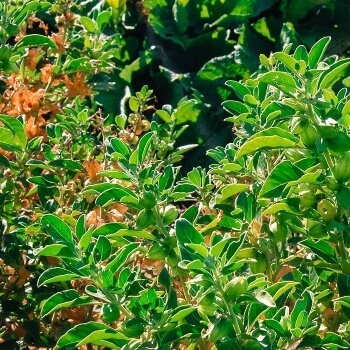




Hi
Im in Perth and would like to buy a plant.
Do you know where I can get one?
Hi Matt,
I hope you’re doing great! While I don’t have a specific shop to suggest, you can start your plant-hunting by searching for ‘where to buy ashwagandha plants in Perth’ To narrow it down, you can also try ‘where to buy plants near [your zip code]’ or simply ‘plants near me.’
Happy plant hunting!
Best regards,
Maisie Blevins
Hi Maisie,
Thank you for all that great information on growing ashwagandha. I live in NSW, on a sand hill, so I have been building it up my soil for past 20 years. Now it is very dark, almost black, from all the composting I've done and I have found my ashwagandha plants thrive in this soil, and self sow everywhere! I've been growing and harvesting them into powder for few years.
My question wether the potency of the roots is higher if harvested in its second year Autumn? (21 mths old) Or is it of higher potency at its first Autumn?
Thank you for your help and great website.
Hi Maisie,
Thank you for all that great information on growing ashwagandha. I live in NSW, on a sand hill, so I have been building it up my soil for past 20 years.
Now it is very dark, almost black, from all the composting I've done and I have found my ashwagandha plants thrive in this soil, and self sow everywhere! I've been growing and harvesting them into powder for few years.
My question wether the potency of the roots is higher if harvested in its second year Autumn? (21 mths old) Or is it of higher potency at its first Autumn?
Thank you for your help and great website.
Hi,
Thank you for sharing your gardening experience and your question about harvesting ashwagandha roots! The potency of ashwagandha roots is generally considered to be highest when harvested at the end of the plant’s first year, typically in autumn. This is because, during the first year, the plant directs its energy into root development, which results in more concentrated active compounds, such as withanolides, which are responsible for the herb’s medicinal properties.
Harvesting in the second year (around 21 months old) might still yield potent roots, but the plant starts to direct energy towards flowering and seed production, which can slightly reduce the concentration of beneficial compounds in the roots. Therefore, the first autumn (around 9-12 months old) is generally recommended for the highest potency in ashwagandha root harvest.
However, some gardeners and herbalists do prefer to harvest in the second year for larger roots, but it’s a balance between root size and potency. Since you’ve been growing and harvesting successfully, you could compare the effects of roots harvested at different stages to find what works best for you!
Maisie Blevins
Aussie Green Thumb